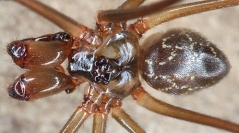

 European Journal of Taxonomy
909 (1) - Pages 1-63
European Journal of Taxonomy
909 (1) - Pages 1-63The Andean genus Priscula Simon, 1893 includes the largest Neotropical pholcid spiders, but due to their mostly cryptic lifestyle they remain poorly collected and poorly studied. Many species available in collections remain undescribed and nothing has been published about the phylogeny and the biology of the genus. Here, we deal with a recent collection of Priscula spiders from Ecuador, the country of origin of the type species, P. gularis Simon, 1893. We describe eight new species, collected at 17 localities at altitudes from 640–3160 m, all based on males and females: P. azuay sp. nov., P. llaviucu sp. nov., P. espejoi sp. nov., P. esmeraldas sp. nov., P. chapintza sp. nov., P. pastaza sp. nov., P. bonita sp. nov., and P. lumbaqui sp. nov. We use a sample of approximately 26 species-level taxa, mostly from Ecuador and Venezuela, to propose a first hypothesis about relationships within the genus. Our data (mainly CO1) suggest the existence of five species groups, three of which are represented in Ecuador. The cave-dwelling P. pastaza sp. nov. is only slightly troglomorphic (paler than usual; anterior median eyes strongly reduced or lost) but differs dramatically from forest-dwelling congeners in its biology: it hangs fully exposed in its web during the day; it produces egg sacs with only 6–7 eggs (average in 15 other species: 42 eggs); and it produces the largest eggs relative to body size of all studied species.